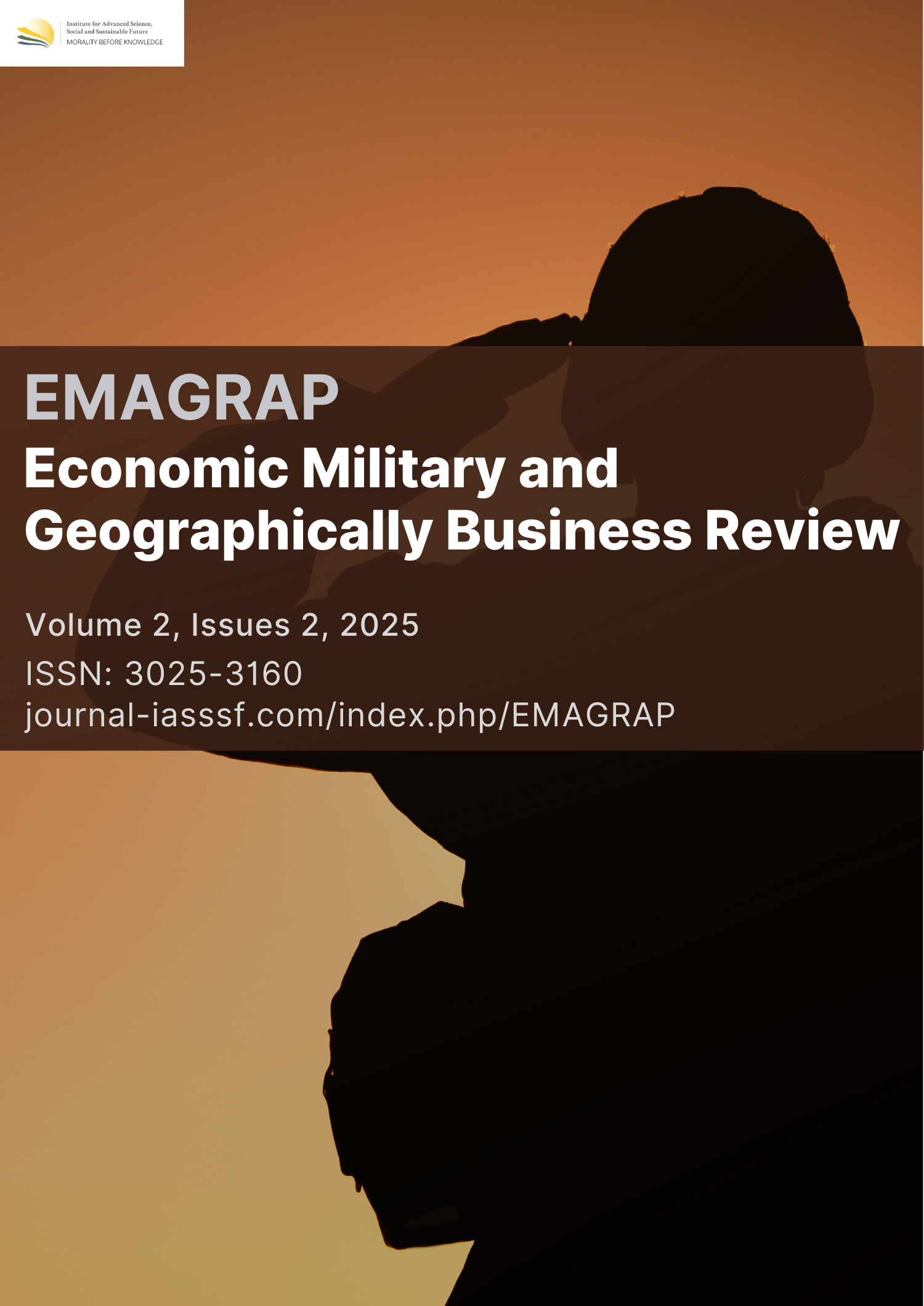Comparative study of infrastructure development and its impact on human development index: Economic and geographical insights
DOI:
https://doi.org/10.61511/emagrap.v2i2.2025.1518Keywords:
development, education, health, human development index, infrastructureAbstract
Background: Urban-focused development can lead to disparities in infrastructure and transportation development. The lack of adequate infrastructure causes many people to live isolated in remote areas, hindering their access to resources and basic services. Methods: This contributes to high poverty levels and low human development in those regions. The absence of infrastructure results in many communities being trapped in impoverished, remote areas, making it essential to open access to facilitate development. Findings: The Human Development Index (HDI) is an important indicator to ensure the achievement of the goal that people have a good quality of life, including the ability to live healthily and for a long time, access education, gain knowledge, and have access to employment opportunities, social protection programs, and other resources needed to achieve a decent life. The acceleration of HDI growth in 2023 is partly driven by the standard of living dimension, represented by real per capita expenditure, health (life expectancy at birth), and knowledge (average years of schooling and expected years of schooling). Conclusion: To achieve sustainable and just development, infrastructure is needed to improve accessibility and connectivity between regions to encourage economic growth and community well-being. Novelty/Originality of this article: This study highlights the critical role of infrastructure in reducing regional disparities and accelerating human development, emphasizing its impact on HDI growth—an aspect often overlooked in previous research.
References
Alkire, S., & Santos, M. E. (2011). Acute multidimensional poverty: A new index for developing countries. Proceedings of the German Development Economics Conference, 2011 (Berlin). https://www.econstor.eu/handle/10419/48297
Annisaa, A., Rochmah, S. N., & Alma, L. R. (2023). Modeling the human development index seen from the aspect of public health in East Java. Populasi, 31(2), 32-48. https://doi.org/10.22146/jp.92548
Arcury, T. A., Preisser, J. S., Gesler, W. M., & Powers, J. M. (2005). Access to transportation and health care utilization in a rural region. The Journal of Rural Health, 21(1), 31-38. https://doi.org/10.1111/j.1748-0361.2005.tb00059.x
Atmaja, H. K., & Mahalli, K. (2015). Pengaruh peningkatan infrastruktur terhadap pertumbuhan ekonomi di Kota Sibolga. Jurnal Ekonomi dan keuangan, 3(4), 14847. https://repositori.usu.ac.id/handle/123456789/67986
Banerjee, A., Duflo, E., & Qian, N. (2020). On the road: Access to transportation infrastructure and economic growth in China. Journal of Development Economics, 145, 102442. https://doi.org/10.1016/j.jdeveco.2020.102442
Bank Indonesia. (2021). Financial inclusion and digital economy: An overview of Indonesia's progress. Bank Indonesia. https://www.bi.go.id/id/bi-institute/BI-Epsilon/Pages/Inklusi-Keuangan-Digital-Dorong-Pertumbuhan-Ekonomi.aspx
Barrientos, A. (2013). Social protection for poverty reduction: Approaches, effectiveness and challenges. In Social Protection in Developing Countries (pp. 24-32). Routledge. eBook ISBN: 9780203082294. https://www.taylorfrancis.com/chapters/edit/10.4324/9780203082294-4/social-protection-poverty-reduction-armando-barrientos
Becker, G. S. (1964). Human capital: a theoretical and empirical analysis, with special reference to education (Vol. 3). University of Chicago Press.
Borensztein, E., De Gregorio, J., & Lee, J. W. (1998). How does foreign direct investment affect economic growth?. Journal of international Economics, 45(1), 115-135. https://doi.org/10.1016/S0022-1996(97)00033-0
Bourguignon, F., & Chakravarty, S. R. (2003). The measurement of multidimensional poverty. The Journal of Economic Inequality, 1, 25-49. https://doi.org/10.1023/A:1023913831342
BPS Indonesia. (2022). Indonesian regional economic report 2022. BPS Indonesia. https://www.bps.go.id/id/publication/2022/09/16/2ff6faa58654862615a92019/laporan-perekonomian-indonesia-2022.html
BPS Indonesia. (2023). Indeks pembangunan manusia menurut Provinsi, 2023. Badan Pusat Statistik. https://www.bps.go.id/id/statistics-table/3/V25GaFNHaExaMnhITm1sWmRrUlJZelJzYUc1SGR6MDkjMw==/indeks-pembangunan-manusia-menurut-provinsi.html?year=2023
De Fretes, P. (2017). Pengaruh dana perimbangan, pendapatan asli daerah, dan pertumbuhan ekonomi terhadap indeks pembangunan manusia di Kabupaten Kepulauan Yapen. JAE (Jurnal Akuntansi Dan Ekonomi), 2(2), 1-33.https://doi.org/10.29407/jae.v2i2.864
Demirguc-Kunt, A., Klapper, L., Singer, D., Ansar, S., & Hess, J. (2018). The global findex database 2017: Measuring financial inclusion and the fintech revolution. World Bank Publications. https://hdl.handle.net/10986/29510
Fauzi, F. Z., Murti, A. G. B., Imamah, L. A., & Hapsari, N. (2019). Infrastructure development in papua: Features and challenges. Policy & Governance Review, 3(3), 225-243. https://doi.org/10.30589/pgr.v3i3.162
Ghosh, M. (2017). Infrastructure and development in rural India. Margin: The Journal of Applied Economic Research, 11(3), 256-289. https://doi.org/10.1177/0973801017703499
Hanushek, E. A., & Woessmann, L. (2008). The role of cognitive skills in economic development. Journal of economic literature, 46(3), 607-668. https://doi.org/10.1257/jel.46.3.607
Hariyanto, M. V., & Purwanti, P. A. P. (2020). Analisis Pertumbuhan Ekonomi dan Indeks Pembangunan Manusia di Kabupaten/Kota Provinsi Bali (Metode Kointegrasi). Media Trend, 15(1), 52-61. https://doi.org/10.21107/mediatrend.v15i1.6746
Linda, R. (2016). Kausalitas dan kointegrasi antara pengeluaran pemerintah dan pertumbuhan ekonomi kurun waktu 1983-2104. Kutubkhanah, 19(2), 262-278. http://dx.doi.org/10.24014/kutubkhanah.v19i2.2556
Mahendra, A. (2020). Analisis Pengaruh Pengeluaran Pemerintah Sektor Pendidikan Dan Kesehatan, Inflasi Dan Kemiskinan Terhadap Indeks Pembangunan Manusia Dengan Pertumbuhan Ekonomi Sebagai Variabel Moderating Di Indonesia. Jurnal Manajemen Dan Bisnis, 174-186. https://doi.org/10.54367/jmb.v20i2.1010
Maimunah, S., Apsari, N. C., & Rachim, H. A. (2024). Aksesibilitas inklusif: Implementasi infrastruktur publik ramah disabilitas di Indonesia (sebuah literatur reveiw). Focus: Jurnal Pekerjaan Sosial, 7(2), 250-276. https://doi.org/10.24198/focus.v7i2.60851
McKinnon, R. I. (2010). Money and capital in economic development. Brookings Institution Press. https://www.brookings.edu/books/money-and-capital-in-economic-development/
Ministry of Finance Indonesia. (2021). Fiscal policy for sustainable development: Achievements and challenges. Ministry of Finance Indonesia. https://fiskal.kemenkeu.go.id/files/kemppkf/file/kem_ppkf_2021.pdf
Mongan, J. J. S. (2019). Pengaruh pengeluaran pemerintah bidang pendidikan dan kesehatan terhadap indeks pembangunan manusia di Indonesia. Indonesian Treasury Review: Jurnal Perbendaharaan, Keuangan Negara dan Kebijakan Publik, 4(2), 163-176. https://doi.org/10.33105/itrev.v4i2.122
OECD. (2020). Economic policy reforms 2020: Going for growth. OECD Publishing. https://www.oecd.org/content/dam/oecd/en/publications/reports/2018/03/economic-policy-reforms-2018_g1g8a996/growth-2018-en.pdf
Razmi, M. J., Abbasian, E., & Mohammadi, S. (2012). Investigating the effect of government health expenditure on HDI in Iran. Journal of Knowledge Management, Economics and Information Technology, 2(5). http://www.scientificpapers.org/download/247/
Rodríguez‐Pose, A., & Krøijer, A. (2009). Fiscal decentralization and economic growth in Central and Eastern Europe. Growth and change, 40(3), 387-417. https://doi.org/10.1111/j.1468-2257.2009.00488.x
Salehuddin, S., Oruh, S., Agustang, A., & Maswati, R. (2023). Inklusi pendidikan dan dinamika kebudayaan lokal di Papua. Edu Sociata: Jurnal Pendidikan Sosiologi, 6(2), 1413-1424. https://doi.org/10.33627/es.v6i2.1718
Siregar, D. R., & Tanjung A. A. (2020). Pengaruh infrastruktur dan indeks pembangunan manusia terhadap pertumbuhan ekonomi kabupaten langkat 2010-2019. Jurnal ekonomi Bisnis, 19(2), 173-180. https://doi.org/10.32722/eb.v19i2.3450
Sontosudarmo, A. (1990). Perkembangan Kualitas Sumberdaya Manusia Indonesia: Antara Harapan dan Kenyataan. Majalah Geografi Indonesia, 6(9). https://doi.org/10.22146/mgi.6755
Suparno, H. (2014). Pengaruh pengeluaran pemerintah sektor pendidikan, kesehatan dan infrastuktur terhadap pertumbuhan ekonomi dan peningkatan pembangunan manusia di Provinsi Kalimantan Timur. Journal of Innovation in Business and Economics, 5(1), 1-22. https://ejournal.umm.ac.id/index.php/jibe/article/view/2254
Suripto, S., & Lestari, E. D. (2019). Pengaruh pembangunan infrastruktur terhadap PDRB di provinsi Indonesia. Wahana: Jurnal Ekonomi, Manajemen dan Akuntansi, 22(1), 15-27. https://doi.org/10.35591/wahana.v22i1.146
Susanto, R., & Pangesti, I. (2019). Pengaruh tingkat pendidikan terhadap kemiskinan di DKI Jakarta. JABE (Journal of Applied Business and Economic), 5(4), 340-350. http://dx.doi.org/10.30998/jabe.v5i4.4183
Tiwari, A. K., Shahbaz, M., & Islam, F. (2013). Does financial development increase rural‐urban income inequality? Cointegration analysis in the case of Indian economy. International Journal of Social Economics, 40(2), 151-168. https://doi.org/10.1108/03068291311283616
Todaro, M. P., & Smith, S. C. (2015). Economic development. Pearson.
Todaro, M. P., & Smith, S. C. (2020). Economic development (13th ed.). Pearson. https://students.aiu.edu/submissions/profiles/resources/onlineBook/F5v9e6_Economic%20Development-2020.pdf
UNDP. (2022). Human Development Report 2021-22. United Nations Development Programme. https://hdr.undp.org/content/human-development-report-2021-22
Weya, I., & Lubis, I. (2022, April). Pengaruh pembangunan manusia dan pembangunan infrastruktur terhadap pertumbuhan ekonomi di Provinsi Papua. In Seminar Nasional Pariwisata dan Kewirausahaan (SNPK): Vol. 1. (pp. 516-527). https://doi.org/10.36441/snpk.vol1.2022.81
World Bank. (2020). The state of social safety nets 2020. World Bank. https://www.worldbank.org/en/topic/safetynets#1
World Bank. (2021). Regional economic outlook for Indonesia. World Bank. https://www.worldbank.org/en/country/indonesia/publication/indonesia-economic-prospect
Zumaeroh, Z., Fatmawati, A., & Dwi, P. S. (2023). Determinan Pembangunan Manusia di Provinsi Papua. Majalah Imiah Manajemen dan Bisnis, 20(1), 67-75. https://mimb.unwiku.ac.id/index.php/mimb/article/view/173/126
Downloads
Published
How to Cite
Issue
Section
Citation Check
License
Copyright (c) 2025 Ibnu Hafizh Syam

This work is licensed under a Creative Commons Attribution 4.0 International License.














